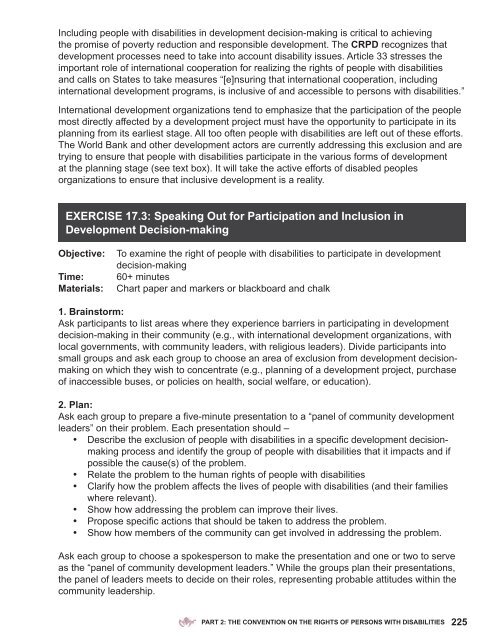Full page photo print - Harvard Law School Project on Disability
Full page photo print - Harvard Law School Project on Disability
Full page photo print - Harvard Law School Project on Disability
Create successful ePaper yourself
Turn your PDF publications into a flip-book with our unique Google optimized e-Paper software.
Including people with disabilities in development decisi<strong>on</strong>-making is critical to achieving<br />
the promise of poverty reducti<strong>on</strong> and resp<strong>on</strong>sible development. The cRPd recognizes that<br />
development processes need to take into account disability issues. Article 33 stresses the<br />
important role of internati<strong>on</strong>al cooperati<strong>on</strong> for realizing the rights of people with disabilities<br />
and calls <strong>on</strong> States to take measures “[e]nsuring that internati<strong>on</strong>al cooperati<strong>on</strong>, including<br />
internati<strong>on</strong>al development programs, is inclusive of and accessible to pers<strong>on</strong>s with disabilities.”<br />
Internati<strong>on</strong>al development organizati<strong>on</strong>s tend to emphasize that the participati<strong>on</strong> of the people<br />
most directly affected by a development project must have the opportunity to participate in its<br />
planning from its earliest stage. All too often people with disabilities are left out of these efforts.<br />
The World Bank and other development actors are currently addressing this exclusi<strong>on</strong> and are<br />
trying to ensure that people with disabilities participate in the various forms of development<br />
at the planning stage (see text box). It will take the active efforts of disabled peoples<br />
organizati<strong>on</strong>s to ensure that inclusive development is a reality.<br />
exeRcise 17.3: speaking out for Participati<strong>on</strong> and inclusi<strong>on</strong> in<br />
development decisi<strong>on</strong>-making<br />
objective: To examine the right of people with disabilities to participate in development<br />
decisi<strong>on</strong>-making<br />
Time: 60+ minutes<br />
Materials: Chart paper and markers or blackboard and chalk<br />
1. brainstorm:<br />
Ask participants to list areas where they experience barriers in participating in development<br />
decisi<strong>on</strong>-making in their community (e.g., with internati<strong>on</strong>al development organizati<strong>on</strong>s, with<br />
local governments, with community leaders, with religious leaders). Divide participants into<br />
small groups and ask each group to choose an area of exclusi<strong>on</strong> from development decisi<strong>on</strong>making<br />
<strong>on</strong> which they wish to c<strong>on</strong>centrate (e.g., planning of a development project, purchase<br />
of inaccessible buses, or policies <strong>on</strong> health, social welfare, or educati<strong>on</strong>).<br />
2. Plan:<br />
Ask each group to prepare a five-minute presentati<strong>on</strong> to a “panel of community development<br />
leaders” <strong>on</strong> their problem. Each presentati<strong>on</strong> should –<br />
• Describe the exclusi<strong>on</strong> of people with disabilities in a specific development decisi<strong>on</strong>making<br />
process and identify the group of people with disabilities that it impacts and if<br />
possible the cause(s) of the problem.<br />
• Relate the problem to the human rights of people with disabilities<br />
• Clarify how the problem affects the lives of people with disabilities (and their families<br />
where relevant).<br />
• Show how addressing the problem can improve their lives.<br />
• Propose specific acti<strong>on</strong>s that should be taken to address the problem.<br />
• Show how members of the community can get involved in addressing the problem.<br />
Ask each group to choose a spokespers<strong>on</strong> to make the presentati<strong>on</strong> and <strong>on</strong>e or two to serve<br />
as the “panel of community development leaders.” While the groups plan their presentati<strong>on</strong>s,<br />
the panel of leaders meets to decide <strong>on</strong> their roles, representing probable attitudes within the<br />
community leadership.<br />
PART 2: The c<strong>on</strong>venTi<strong>on</strong> <strong>on</strong> The RighTs of PeRs<strong>on</strong>s wiTh disAbiliTies<br />
225




